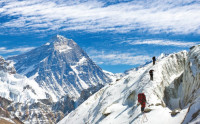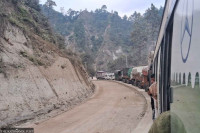Opinion
Escaping the ‘tourism trap’
Tourism Trap, Lisa Abend’s cover story for a recent issue of the Time Magazine, highlighted the changes brought about by mass tourism in Europe and captured how local residents and governments have reacted to the issue.
Kashif Islam
Tourism Trap, Lisa Abend’s cover story for a recent issue of the Time Magazine, highlighted the changes brought about by mass tourism in Europe and captured how local residents and governments have reacted to the issue. The numbers are astonishing: the old continent saw a record 500 million-plus international tourists in 2017, up from 250 million in 1990. France, with Paris as the world’s most visited city was the leader, followed by Spain and Italy.
Tourism is hardly new in Europe but it seems to have reached a tipping point, prompting several European cities to take mitigating steps. Barcelona restricts entries to large groups to its famed local markets and is currently taking steps to ensure that locals can shop for their essentials; Venice closed a section of the city to tourists and is planning to ban large cruise ships from docking; Amsterdam fines tourists for misdemeanours; even Iceland, a country with less than a million people is contemplating restrictions on the number of visitors. The list goes on.
Tourism’s adverse impacts
Mass tourism—as a social, economic, and political phenomenon—dates back to 1930s Europe, the time when industrial workers started enjoying paid vacations. As long as travel remained limited and costly, tourism continued to be a localised phenomenon. However, with the proliferation of cheap air travel and increasing affluence, it underwent a big change from the 1990s onwards. Consequently, the number of foreign trips worldwide has doubled in the past two decades to reach a billion yearly trips. Affordable and easily accessible house-renting sites such as BnB have only intensified the trend.
With each passing year, the boundaries of tourism are pushed further afar, along with the discovery of ever exotic hotspots and circuits. The motivations are many, from seeking a break from the routine, experiencing ‘colourful’ local culture and visiting places of natural beauty to sex and drugs. From the beaches of Thailand to the Australian outback and from the fjords of Norway to the Patagonian desert, few places have remained untouched.
In fact, tourist agencies are now organising cruises to the Arctic and Antarctic, the last frontiers of mass tourism. Such a phenomenon could hardly be without effects. Sociologists use the term ‘touristification’ to describe the shift in local economies to meet the needs of tourists at the expense of locals. Several of the people quoted in the Time article complained about crowded public transport, local markets, and parks. Reports published elsewhere show how, in many places, rising property prices and a lower quality of life brought by mass tourism has forced many locals to move out.
Tourism is also not kind to the environment. According to a wide-ranging study conducted by Australian scientists in 2018, tourism-related activities were responsible for around 10 percent of global greenhouse gas emissions.
Air travel, on which much of international tourism depends, accounted for a good chunk of these emissions. Apart from emissions, tourism entails the creation of supporting infrastructure in the form of power lines, roads, hotels, resorts and the like, often with great loss to the natural habitat. Littered beaches and piles of trash are only the most visible signs of this.
Developing countries are especially vulnerable. Here, poverty is widespread and there is a pressing need to attract more tourists; at the same time, the mechanisms for coping with mass tourism as well as regulations regarding environment are barely developed and, in many cases, poorly enforced. This poses serious challenges for the natural habitat and endangers the livelihood of local people.
Nepal’s context
For a small country like Nepal, the challenges are even greater. As per available reports, tourism contributes up to 10 percent of the country’s domestic product and is an important avenue for employment—especially for a country where eight out of 10 people still derive sustenance from agriculture. Careful, regulated tourism holds the potential to improve people’s lives and provide incentives for protecting the cultural and natural heritage of the country.
However, Nepal is no pristine territory waiting to be discovered by tourists. Increasing population and decades of unsustainable energy use have already depleted much of the land and forest resources. It is estimated that the country’s forested area reduced from 33 percent of the total area to 25 percent just between 1990 and 2005 (a loss of around a million hectares). Like other South-Asian countries, enforcement of environmental regulations is lax and air and water pollution are serious concerns.
From its earliest days, tourism was always a mixed blessing to the country. It brought in much-needed foreign exchange and provided some avenues for employment. But already in 1986, Cultural Survival, a non-governmental organisation comprised of a network of Indigenous partners and international human rights advocates, reported about lodges coming up in sanctuaries, the littering of trails and excessive firewood use by trekking parties. Also, there were rumblings about the loss of self-reliance of hill dwellers.
And, this was when the number of tourists was a fraction of the current levels. It is in this context that one must view the ambitious ‘Visit Nepal 2020’ program that aims to double the number of overseas tourists visiting the country with a more critical lens. Implicit in this vision is the assumption that tourism provides a relatively-low impact way of growing the economy; yet, the authors of the aforementioned study issued several warnings against just this sort of assumption by revealing the cumulative impacts of tourism.
In practical terms, attracting more tourists will require improving the existing infrastructure as well as create pressure for more infrastructure in the form of hotels, camps, roads, and airports. For a country with lax environmental oversight, much of this is likely to come up in sensitive eco-zones without consideration of ecological principles. Also, unless intentionally designed otherwise, much of the benefits of the increased tourists continue to benefit large-scale entrenched businesses with clear political interests compared to those living in poverty.
Moreover, ecological damage can have catastrophic effects such as that experienced by the north Indian hill state of Uttarakhand in 2013. Visited by large numbers of religious tourists, the state had been subject to unplanned construction, deforestation and hydroelectric projects involving massive drilling, all of which exacerbated the rapid run-off after the unprecedented rains—which lead to flash floods and landslides. With climate-change-induced extreme weather events likely to become more frequent, ecological damage may increase the vulnerability of local communities to natural disasters.
Ultimately, in tourism as with the economy, there is a pressing need to focus on quality and not just the numbers. At this pivotal juncture, the government has two choices: Would Nepal rather have a more reasonable number of tourists that can be successfully managed without further stresses on the environment and with clear benefits to indigenous people and local communities? Or should the country follow the philosophy of ‘more is better’ and run the risk of having far too many tourists with little control over the attendant social and environmental impacts?
- Islam works at HSBC Bangalore and is a graduate of Jawaharlal Nehru University.




 13.93°C Kathmandu
13.93°C Kathmandu












